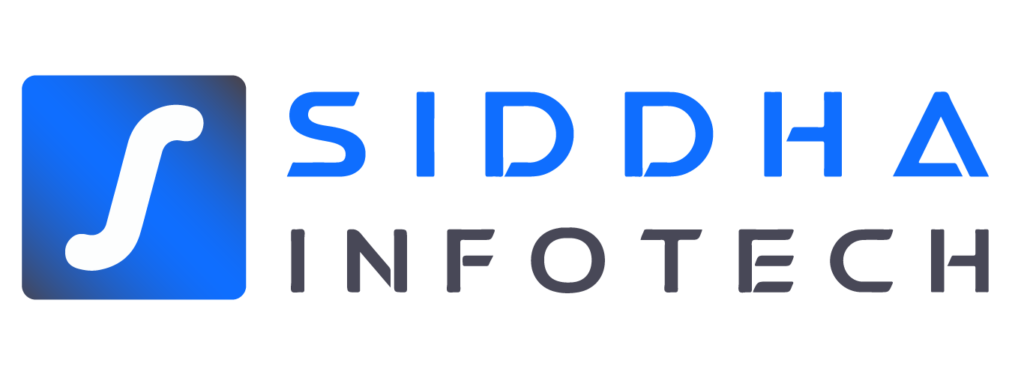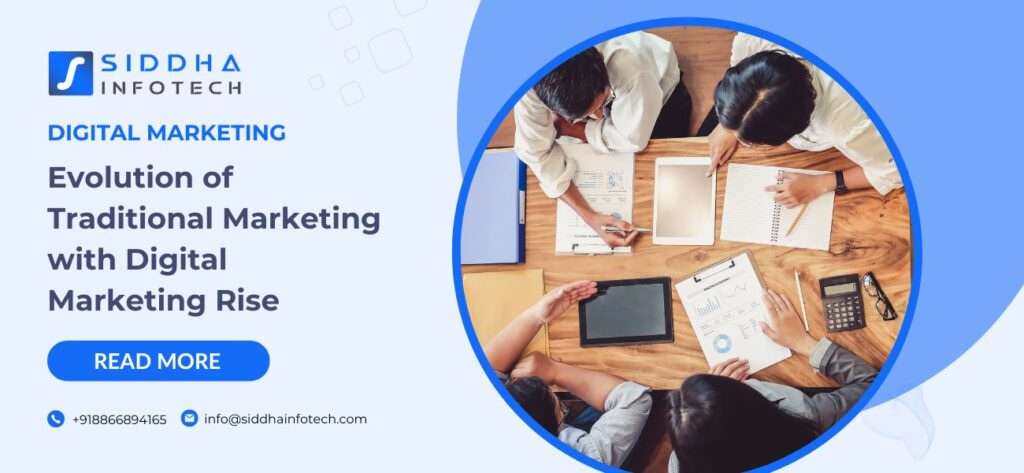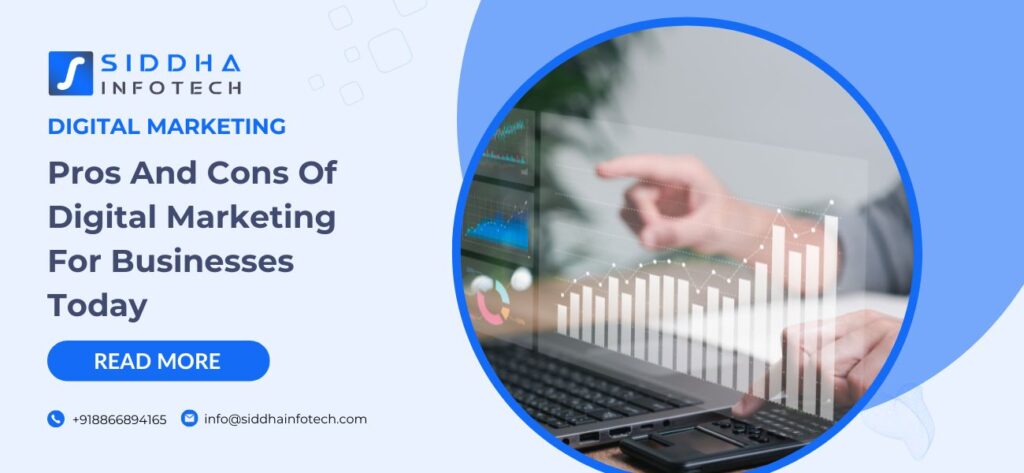Evolution of Traditional Marketing with Digital Marketing Rise
The marketing landscape has undergone significant transformation over the past few decades. Traditional marketing techniques that once dominated the industry have evolved, integrating with and often giving way to digital marketing strategies. This shift has been driven by technological advancements, changing consumer behaviors, and the vast reach of the internet. At Siddha Infotech, we explore how these changes have shaped the current marketing environment and what they mean for businesses looking to thrive in the digital age.
The digital marketing rise has revolutionized how businesses connect with consumers. With the proliferation of smartphones and social media, companies can reach their target audiences more effectively and efficiently than ever before. Digital marketing tools like SEO, content marketing, and social media advertising allow for precise targeting and real-time engagement. This shift has not only increased the visibility of brands but also provided valuable insights through analytics, enabling continuous improvement of marketing strategies. Embracing the digital marketing rise is essential for any business looking to stay competitive in today's fast-paced, technology-driven world.
Traditional Marketing: A Foundation Built on Experience
Traditional marketing encompasses a range of strategies that have been used for decades, if not centuries. These include print advertising, broadcast media (TV and radio), direct mail, and outdoor advertising such as billboards. These methods have been effective in building brand awareness, reaching mass audiences, and driving sales.
Print Advertising: Newspapers, magazines, brochures, and flyers have been staples of traditional marketing. They allow for detailed information about products and services and provide a tangible medium that consumers can engage with.
Broadcast Media: Television and radio ads have the advantage of reaching wide audiences quickly. They combine audio and visual elements to create memorable messages that can influence consumer behavior.
Direct Mail: Personalized letters, postcards, and catalogs sent to consumers' homes can be highly effective, especially when targeting specific demographics.
Outdoor Advertising: Billboards, posters, and transit ads capture attention in high-traffic areas, offering constant exposure to a brand's message.
Despite the effectiveness of these methods, traditional marketing has its limitations. It can be costly, difficult to measure, and often lacks the targeted approach that digital marketing offers.
The Rise of Digital Marketing
Digital marketing emerged as the internet became more accessible and technology more advanced. It encompasses various online strategies designed to engage consumers through digital channels. Key components include:
Search Engine Optimization (SEO): This involves optimizing a website to rank higher in search engine results pages (SERPs), increasing visibility and attracting organic traffic.
Content Marketing: Creating valuable, relevant content to attract and engage a target audience. This can include blog posts, videos, infographics, and eBooks.
Social Media Marketing: Leveraging platforms like Facebook, Instagram, Twitter, and LinkedIn to reach and interact with consumers.
Email Marketing: Sending targeted messages directly to consumers' inboxes, fostering relationships, and driving conversions.
Pay-Per-Click (PPC) Advertising: Online ads where advertisers pay each time a user clicks on their ad. This includes Google Ads and social media advertising.
Influencer Marketing: Collaborating with influential figures in a particular industry to promote products or services.
Integrating Traditional and Digital Marketing
Many businesses have found success by integrating traditional and digital marketing strategies. This approach allows them to leverage the strengths of both methods to create comprehensive campaigns. For instance:
-
Using TV and Radio to Drive Online Engagement: Businesses can use traditional media to promote their online presence, encouraging viewers and listeners to visit their website or follow them on social media.
-
Combining Direct Mail with Digital Tools: Direct mail pieces can include QR codes or URLs that lead recipients to landing pages with more information or special offers.
-
Blending Print and Online Content: Magazines and newspapers often have digital counterparts where they can extend their reach and engage with a broader audience.
-
Cross-Promotion on Social Media and Billboards: A catchy billboard ad can drive traffic to a social media campaign, creating a seamless experience for consumers across different platforms.
Measuring Success: Analytics and Adaptation
One of the significant advantages of digital marketing is the ability to measure and analyze results in real-time. Tools like Google Analytics, social media insights, and email marketing software provide detailed data on consumer behavior and campaign performance. This data allows businesses to adapt their strategies quickly, optimizing for better results.
In contrast, traditional marketing often relies on estimates and less precise metrics, making it harder to track return on investment (ROI). However, by integrating digital tools, businesses can gain better insights into how traditional methods are performing and adjust accordingly.
Case Studies: Success Stories
Several companies have successfully navigated the transition from traditional to digital marketing, reaping the benefits of both approaches. For example:
Coca-Cola: Known for its iconic TV commercials and print ads, Coca-Cola has also embraced digital marketing. The brand uses social media, content marketing, and online campaigns to reach younger audiences and maintain its global presence.
Nike: Combining traditional media with cutting-edge digital campaigns, Nike has created a powerful brand narrative. Their use of influencer marketing, social media, and immersive online experiences complements their traditional advertising efforts.
Procter & Gamble (P&G): P&G integrates digital marketing with traditional methods to drive brand loyalty and sales. Their campaigns often use TV ads to drive traffic to online platforms where consumers can engage more deeply with the brand.
Future Trends: The Continued Evolution of Marketing
As technology continues to evolve, so too will marketing strategies. Emerging trends include:
Artificial Intelligence (AI): AI is revolutionizing marketing by providing personalized experiences, automating tasks, and offering deep insights through data analysis.
Voice Search Optimization: With the rise of smart speakers, optimizing content for voice search is becoming increasingly important.
Augmented Reality (AR) and Virtual Reality (VR): These technologies offer immersive experiences that can enhance product demonstrations and create memorable consumer interactions.
Video Marketing: Video continues to be a dominant format, with live streaming and short-form content gaining popularity.
Sustainability and Ethical Marketing: Consumers are increasingly concerned with sustainability and ethical practices. Brands that align with these values can build stronger connections with their audience.
Conclusion
The evolution of traditional marketing techniques with the rise of digital marketing has created a dynamic landscape that offers businesses more tools and strategies than ever before. By understanding the strengths and limitations of both traditional and digital methods, companies can create integrated campaigns that effectively reach and engage their target audiences. At Siddha Infotech, we are committed to helping businesses navigate this complex environment, leveraging the latest trends and technologies to achieve their marketing goals.
FAQs
How has traditional marketing adapted to the rise of digital marketing?
Traditional marketing has adapted by integrating digital elements into its strategies. For example, TV ads often include hashtags or social media handles, encouraging viewers to engage online. Print ads may feature QR codes leading to websites or landing pages. Additionally, businesses are using data analytics to measure the impact of traditional methods, allowing for more precise targeting and optimization. This blending of traditional and digital approaches ensures that companies can maintain their reach while taking advantage of the interactive and measurable nature of digital marketing.
What are the main benefits of combining traditional and digital marketing?
Combining traditional and digital marketing allows businesses to leverage the strengths of both approaches. Traditional marketing provides broad reach and brand recognition, while digital marketing offers precise targeting, real-time analytics, and cost-effectiveness. Together, they create a comprehensive strategy that maximizes engagement and ROI. For example, a billboard campaign can drive traffic to a website or social media page, while online ads can reinforce messages seen in print or on TV. This integration ensures a consistent brand message across multiple channels, enhancing overall effectiveness.
What role does content marketing play in the evolution of marketing strategies?
Content marketing plays a crucial role in the evolution of marketing strategies by providing valuable, relevant information that engages and educates consumers. Unlike traditional ads, which often interrupt, content marketing attracts audiences by addressing their needs and interests. This approach builds trust and authority, encouraging long-term relationships. Content marketing includes blogs, videos, infographics, and social media posts, all of which can be shared and amplified digitally. As consumers increasingly seek out information online, content marketing becomes a key component in capturing attention and driving conversions.





